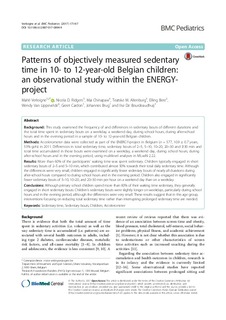| dc.description.abstract | Background: This study examined the frequency of and differences in sedentary bouts of different durations and the total time spent in sedentary bouts on a weekday, a weekend day, during school hours, during after-school hours and in the evening period in a sample of 10- to 12-year-old Belgian children.
Methods: Accelerometer data were collected as part of the ENERGY-project in Belgium (n = 577, 10.9 ± 0.7 years, 53% girls) in 2011. Differences in total sedentary time, sedentary bouts of 2–5, 5–10, 10–20, 20–30 and ≥30 min and total time accumulated in those bouts were examined on a weekday, a weekend day, during school hours, during after-school hours and in the evening period, using multilevel analyses in MLwiN 2.22.
Results: More than 60% of the participants’ waking time was spent sedentary. Children typically engaged in short sedentary bouts of 2–5 and 5–10 min, which contributed almost 50% towards their total daily sedentary time. Although the differences were very small, children engaged in significantly fewer sedentary bouts of nearly all durations during after-school hours compared to during school hours and in the evening period. Children also engaged in significantly fewer sedentary bouts of 5–10, 10–20, and 20–30 min per hour on a weekend day than on a weekday.
Conclusions: Although primary school children spend more than 60% of their waking time sedentary, they generally engaged in short sedentary bouts. Children’s sedentary bouts were slightly longer on weekdays, particularly during school hours and in the evening period, although the differences were very small. These results suggest that in this age group, interventions focusing on reducing total sedentary time rather than interrupting prolonged sedentary time are needed.
Keywords: Sedentary time, Sedentary bouts, Children, Accelerometer | nb_NO |

